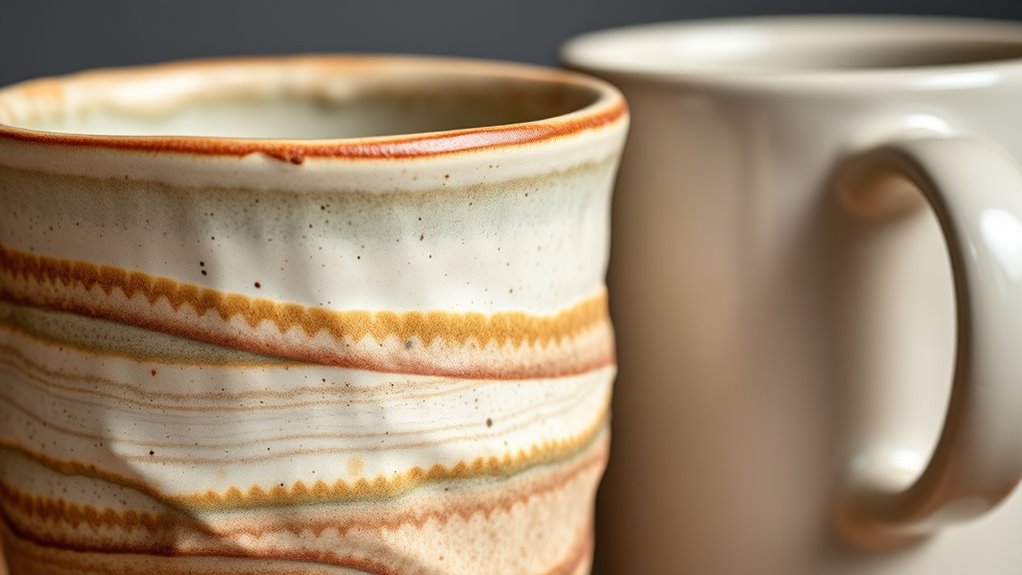To spot quality in artisan ceramics versus mass-produced items, look for irregularities like slight asymmetries, glaze imperfections, or textured surfaces—they show handcrafted charm. Artisan pieces often have subtle variations that add character, while factory-made items tend to be perfectly uniform. If you focus on these details, you’ll better understand the craftsmanship behind each piece. Keep exploring to discover even more ways to distinguish genuine artisan work from machine-made goods.
Key Takeaways
- Artisan ceramics often feature subtle irregularities and glazing imperfections, reflecting handcrafted techniques, while mass-produced items are uniformly finished.
- Variations in texture, shape, and glaze are common in artisan pieces, whereas factory-made ceramics maintain consistent appearance and dimensions.
- Handcrafted ceramics may display unique character and slight asymmetries, indicating individual artistry; factory items prioritize precision and uniformity.
- Imperfections in artisan ceramics, such as glaze drips or uneven rims, enhance their authenticity and charm, unlike the flawless finish of mass-produced products.
- Quality spotting involves examining the glaze, shape, and texture for signs of handcrafting versus machine precision.

When choosing ceramics, you often face a trade-off between handcrafted artistry and mass-produced efficiency. If you’re drawn to the unique charm of artisan pieces, understanding how handcrafted techniques influence quality is essential. Artisans use traditional methods—throwing on a wheel, hand-building, or glazing by hand—that create subtle variations and textures impossible to replicate in factory settings. These techniques ensure each piece has a distinct character, showcasing the artist’s skill and personal touch. Because of this, no two artisan ceramics are exactly alike, which appeals to collectors and enthusiasts who value individuality and craftsmanship. However, the very nature of handcrafted techniques also means that quality can vary from piece to piece, especially if the artist’s process isn’t highly controlled.
Additionally, artisan ceramics often feature glazing imperfections or slight asymmetries that enhance their uniqueness and aesthetic appeal. On the other hand, mass-produced ceramics prioritize manufacturing consistency. Large factories implement standardized processes, machinery, and quality control systems to produce identical items at scale. This approach guarantees that each piece looks and functions the same, making it ideal for bulk purchasing or everyday use. When you buy mass-produced ceramics, you get reliability—you know what to expect in terms of shape, size, and finish. This consistency is achieved through precise molds, automated glazing, and firing procedures, which minimize defects and irregularities. While this can sometimes mean sacrificing the charm of imperfections found in handcrafted pieces, it also ensures a certain level of durability and uniformity that appeals to those seeking practicality.
Choosing between these two types of ceramics depends on what you value most. If you want a piece that tells a story through its handmade imperfections, then artisan ceramics are your best choice. These pieces often display subtle irregularities in shape, glaze, or texture—signs of the handcrafted techniques used in their creation. Conversely, if you prefer reliability, affordability, and uniformity, mass-produced ceramics deliver consistent quality with less variation. Keep in mind that although factory-made items excel in manufacturing consistency, they may lack the uniqueness and personality that come with artisanal craftsmanship. Ultimately, your decision hinges on whether you prioritize artistic expression and individuality or consistency and practicality in your ceramic collection.
Frequently Asked Questions
How Can I Identify Genuine Artisan Ceramics?
To identify genuine artisan ceramics, look for handcrafted techniques that show unique variations and imperfections, reflecting the artist’s skill. Check for authentic markings or signatures on the piece, which indicate it’s handcrafted. Feel the texture—artisan ceramics often have a more tactile, less uniform feel than mass-produced items. These details help you distinguish genuine artisan ceramics from factory-made ones, ensuring you appreciate the craftsmanship behind each piece.
What Are Common Signs of Poor Quality in Mass-Produced Ceramics?
You can spot poor quality in mass-produced ceramics by looking for glaze imperfections, such as drips or cracks, which indicate rushed or uneven finishing. Uneven thickness in the walls or glaze suggests inconsistent manufacturing processes. Also, check for rough edges or misaligned patterns. These signs show that the piece wasn’t carefully crafted, and it may not be durable or visually appealing. Always inspect closely before purchasing.
Do Artisan Ceramics Require Special Care or Maintenance?
You should handle artisan ceramics with care, especially because their glazing techniques and firing processes can be delicate. Handcrafted pieces might be more prone to chipping or cracking if dropped or exposed to sudden temperature changes. To keep them in top shape, wash gently by hand and avoid extreme temperature shifts. Regularly check for any signs of wear, and store them carefully to preserve their beauty and craftsmanship.
Are Artisan Ceramics More Environmentally Friendly Than Mass-Produced Options?
You might wonder if artisan ceramics are more eco-friendly than mass-produced options. Generally, they tend to be, because artisans often use sustainable practices and eco-friendly materials, reducing environmental impact. Unlike mass production, which relies on large-scale energy consumption and synthetic materials, artisan ceramics focus on craftsmanship, local sourcing, and minimal waste. By choosing artisan, you’re supporting a more sustainable approach that benefits the environment.
How Does the Price Difference Reflect Quality and Craftsmanship?
Like a fine tapestry, higher prices often mirror greater craftsmanship valuation. When you see a significant price difference, it’s a sign of pricing transparency and the artisan’s skill, not just material costs. You’re paying for the time, expertise, and detail behind each piece. Mass-produced items cut corners, but artisan ceramics reflect a dedication to quality, making the price a testament to their artistry and craftsmanship.
Conclusion
When choosing between artisan ceramics and mass-produced pieces, remember that quality often speaks for itself. Did you know that artisan ceramics can take up to ten times longer to craft than factory-made items? By spotting unique details and craftsmanship, you can truly appreciate the artistry behind each piece. So, whether you prefer the charm of handmade or the convenience of mass production, understanding these differences helps you make smarter, more satisfying purchases.









